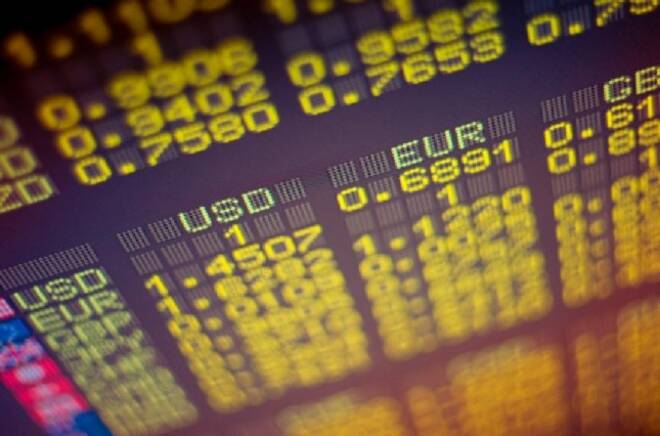Advertisement
Advertisement
EUR/USD Daily Technical Analysis for February 15, 2018
By:
The EUR/USD moved higher pushing through resistance levels and poised to test target resistance. Stronger than expected U.S. CPI initially pushed the
The EUR/USD moved higher pushing through resistance levels and poised to test target resistance. Stronger than expected U.S. CPI initially pushed the currency pair down to support, but the stronger than expected European data, allowed European yields to keep pace with U.S. yields, which helped the currency pair remain buoyed.
Technicals
The EUR/USD pushed through resistance which was prior support near the 10-day moving average at 1.2357. Target resistance is seen near the January highs at 1.2518. Negative momentum is decelerating as the MACD (moving average convergence divergence) histogram prints in the red with an upward sloping trajectory which points to consolidation. The fast stochastic surged higher after recently generating a crossover buy signal which reflects accelerating positive momentum.
Eurozone December industrial production stronger than expected
Eurozone December industrial production stronger than expected at 0.4% month over month. November was revised up to 1.3% month over month from 1.0% month over month reported initially, which left the quarterly growth rate for Q4 at 1.5%, versus 1.3% in the third quarter. The release is overshadowed, by the second reading of Q4 GDP that was released at the same time and showed a deceleration in the quarterly growth rate.
Eurozone Q4 GDP growth was confirmed at 0.6%
Eurozone Q4 GDP growth was confirmed at 0.6% quarter over quarter in line with expectations and the flash reading. The deceleration in the quarterly growth rate from 0.7% quarter over quarter is likely partly due to calendar factors that also underpinned the slowdown in German growth to 0.6% quarter over quarter in the fourth quarter from 0.8% quarter over quarter in Q3. Germany reported strong exports and a pick up in investment for the fourth quarter and looking ahead confidence indicators have been somewhat mixed, but overall are at very high levels, with PMIs reports in particular suggesting capacity constraints and still full order books.
ECB round of Changes begins with Ireland vs Spain
The merry go round of central bank positions that will see major changes at the executive board over the next years starts with the succession for the post of Vice President – currently held by Constancio (Portugal). In theory of course appointments should be based on merit and even national central bank heads should vote in the council meetings with view to the situation in the Eurozone as a whole, rather than national interests, in reality appointments are a complicated game of chess and Finance Ministers, who vote on the nominations will have a wider picture of upcoming posts in mind when choosing candidates.
German GDP growth slowed to 0.6% quarter over quarter
German GDP growth slowed to 0.6% quarter over quarter in Q4, from 0.8% quarter over quarter in the third quarter of the year. We had been looking for a deceleration to 0.7% quarter over quarter, but the 0.6% growth rate was in line with Bloomberg consensus and partly driven by calendar factors with not only more holidays than usual, but also bridging days that added to the slowdown. Working day adjusted annual growth stood at 2.9% year over year up from 2.8% year over year in Q3, and versus just 2.3% year over year for a not working day adjusted annual rate. There is no full breakdown yet, but the statistical office reported that net exports were a main driver of growth, while price consumption growth held pretty much at the level of the third quarter and machinery investment growth improved.
German January HICP inflation was confirmed
German January HICP inflation was confirmed at 1.4% year over year in line with the preliminary number and versus 1.6% year over year in December. the national CPI rate was confirmed at 1.6% year over year versus 1.7% year over year in December. Energy price inflation continued to decelerate, which contributed to the decline in the headline rate and compensated for higher food prices. Food price inflation has been running at 3% and higher since August last year. Rent prices are also picking up. All in all a lower headline rate than initially expected and an HICP rate that is clearly below the ECB’s target, but with wage growth set to pick up after recent wage agreements and with an ever tighter labor market German inflation is likely to continue to trend higher, despite the set back at the start of the year.
U.S. CPI surged 0.5% in January
U.S. CPI surged 0.5% in January with the core rate 0.3% higher, both hotter than expected. Gains were broadbased. The December headline and core rates were each 0.2% higher (revised from 0.1% and 0.3%, respectively following benchmarking). The 12-month headline rates were steady at 2.1% year over year for the headline and 1.8% year over year for the core. Internals showed energy rose 3.0% from the prior -0.2%. Services prices were 0.3% higher.
About the Author
David Beckerauthor
David Becker focuses his attention on various consulting and portfolio management activities at Fortuity LLC, where he currently provides oversight for a multimillion-dollar portfolio consisting of commodities, debt, equities, real estate, and more.
Did you find this article useful?
Latest news and analysis
Advertisement
